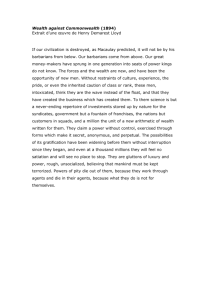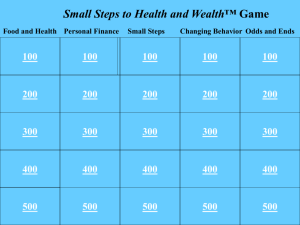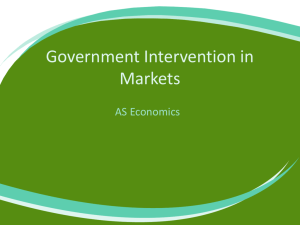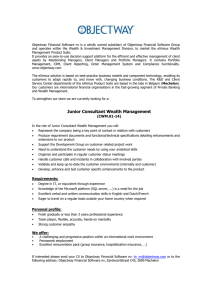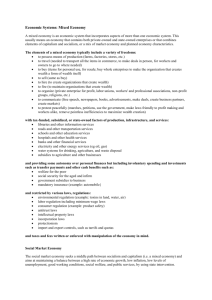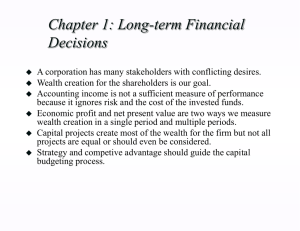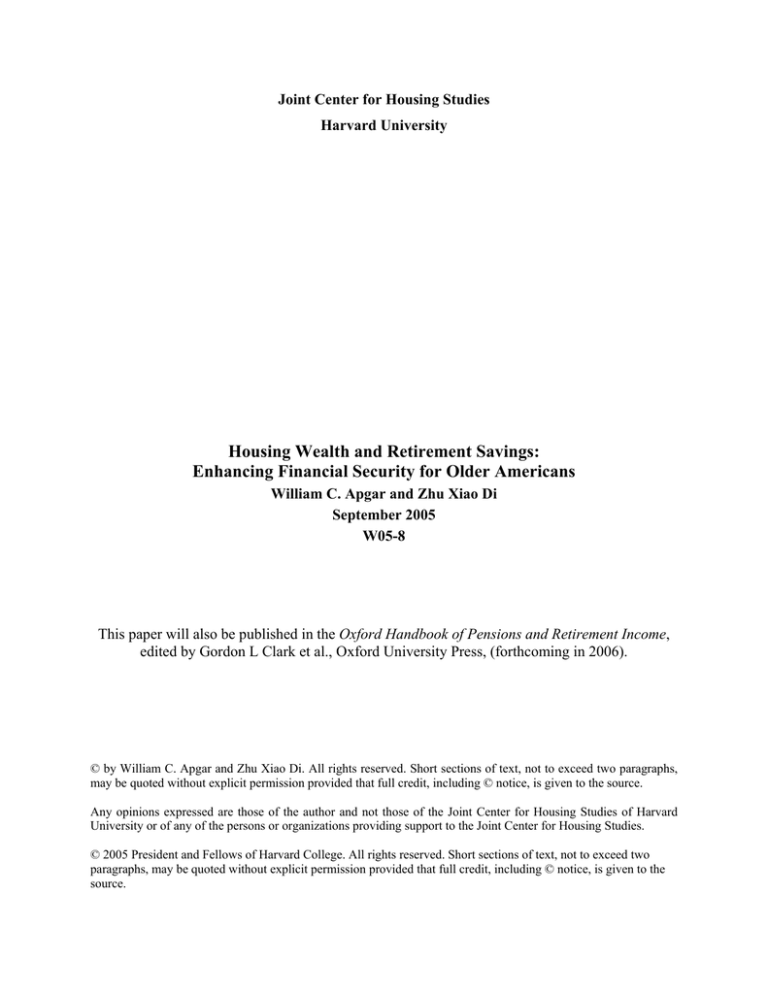
Joint Center for Housing Studies
Harvard University
Housing Wealth and Retirement Savings:
Enhancing Financial Security for Older Americans
William C. Apgar and Zhu Xiao Di
September 2005
W05-8
This paper will also be published in the Oxford Handbook of Pensions and Retirement Income,
edited by Gordon L Clark et al., Oxford University Press, (forthcoming in 2006).
© by William C. Apgar and Zhu Xiao Di. All rights reserved. Short sections of text, not to exceed two paragraphs,
may be quoted without explicit permission provided that full credit, including © notice, is given to the source.
Any opinions expressed are those of the author and not those of the Joint Center for Housing Studies of Harvard
University or of any of the persons or organizations providing support to the Joint Center for Housing Studies.
© 2005 President and Fellows of Harvard College. All rights reserved. Short sections of text, not to exceed two
paragraphs, may be quoted without explicit permission provided that full credit, including © notice, is given to the
source.
Introduction
The rapid rise in home prices in countries around the world has focused new attention on
the role that housing and housing wealth plays in enhancing the financial security for families
and individuals as they move into their retirement years. This is especially true in the United
States where after a decade of steady increases in home values, residential real estate has grown
to become the largest single asset class held by households with heads aged 65 or older. With so
much wealth tied up owner occupied housing, little wonder that the popular press in the United
States provides extensive coverage of the ‘housing bubble’ and what will happen should that
bubble suddenly burst.
Given the importance of housing wealth as an overall component of the wealth holdings
of older homeowners, until recently, surprisingly little was known about how housing wealth
influences the consumption and investment decisions of households, especially as they relate to
retirees. This chapter summarizes available literature on these topics and assesses the pluses and
minuses of having housing wealth play such an important role in providing for the income
security of older homeowners.
There are many reasons to be concerned about the reliance on housing wealth as a source
of retirement savings. Even as homeownership rates continue to rise, millions still rent.
Moreover, there can be little doubt that renters in general, and low-income renters in particular,
face a bleak retirement future given the relatively limited reach of current social security and
other income support systems now in place. But rather than condemn renters to a life of limited
wealth accumulation, it is important to create new investment vehicles that will support savings
and investment by renters. Just as the current housing finance and tax system makes it relatively
easy to invest in real estate, a balanced national housing and income support system should
provide expanded opportunities for renters to accumulate wealth by investing in other financial
assets.
While the situation facing lower-income renters merits special attention, millions of home
owning retired people also face serious challenges. Here it is important to recognize that readily
available national data on wealth trends mask significant regional variation. Housing markets are
distinctly local in nature. Even as home prices move up sharply in one region, they may lag
behind elsewhere. As a result, there is a certain lottery like element to the role that home equity
buildup plays as a source of retirement savings, with the winners generally being those lucky
© 2005 President and Fellows of Harvard College. All rights reserved. Short sections of text, not to exceed two paragraphs,
may be quoted without explicit permission provided that full credit, including © notice, is given to the source.
1
enough to live in areas where home prices have appreciated most rapidly just as they prepare to
move into their retirement years.
While acquiring a home can boost wealth accumulation, many retired people face
unmanageable housing payments burdens. Many own their home ‘free and clear,’ but a growing
number are burdened by the increasing amount of debt they carry into later life. Moreover,
despite these affordability pressures, many elderly people are unwilling or unable to downsize
their consumption of housing. What is needed is the creation of new financial instruments
designed to meet the particular problems faced by ‘house rich, cash poor’ retirees, as well as
expanded efforts to create new affordable housing options that best meet the needs of older
people.
These observations are a reminder that housing wealth accumulation is no substitute for a
comprehensive set of housing and income support policies designed to help households prepare
for retirement. Rather than simply provide income support payments to retirees, the best
retirement support policy will undoubtedly involve a mix of income transfer programs and
housing assistance efforts that enable retired people to sell their homes and tap into accumulated
home equity. Failure to think creatively about how best to coordinate income assistance and
housing assistance efforts will most certainly result in having pension and income support
systems continue to struggle to meet the retirement needs of current and future generations of
retired persons, while at the same time leaving hundreds of billions of dollars of home equity to
sit idly on the sidelines.
This paper is divided into three main sections and a conclusion. The first section
discusses recent trends in wealth accumulation with a particular focus on the accumulation of
housing wealth by older households. The next section examines the impact of housing wealth on
consumption and investment activities, and demonstrates that for most households,
homeownership opens up new pathways for additional wealth accumulation. Given the fact that
housing wealth is the largest component of wealth for most households, the paper then turns to a
discussion of the several significant risks that threaten to undermine the benefit that older
Americans derive from accumulated housing wealth. The concluding section offers some brief
observations on policy approaches designed to enhance the ability of housing wealth to add to
the financial security of older people.
2
© 2005 President and Fellows of Harvard College. All rights reserved. Short sections of text, not to exceed two paragraphs,
may be quoted without explicit permission provided that full credit, including © notice, is given to the source.
Residential Real Estate and the Wealth of Seniors
Housing Equity Key to Growing Wealth for Many Older Homeowners
Over the decade of the 1990s, much of the increase in aggregate wealth holdings was
linked to the growth of wealth among home owning households.1 Median net wealth holdings for
homeowners with heads aged 65 to 74 increased over the 1992 to 2001 period by close to $100
thousand to just shy of $250 thousand. Households with heads aged 75 or older posted similar
gains, while home owning households with heads aged less than 65 added just $42 thousand in
median wealth over the period. In contrast, the wealth of renting households of all ages lagged
far behind owners over the period.
Table 1. Wealth Holdings of Older Homeowners Grew Rapidly in the 1990s
(Median Net Wealth in 2001 Dollars)
1992
2001
Owners
Renters
All
Households
Less than 65
65 to 74
74 or older
$112,300
$151,800
$140,400
$4,400
$4,400
$7,600
$48,500
$122,200
$107,500
$154,100
$249,700
$243,000
$4,500
$6,000
$7,000
$67,900
$176,700
$151,400
All Ages
$123,600
$4,600
$62,100
$171,800
$4,800
$86,100
Age of Head
Owners
Renters
All
Households
Source: Joint Center for Housing Studies Tabulations of Survey of Consumer Finances
See also discussion of these figures in Di (2003)
After a decade of steady increase in home values, now residential real estate represents
the largest single asset class owned by seniors.2 According to the 2001 Survey of Consumer
Finances, over 80 per cent of all seniors owned a home, and these homes were valued at nearly
$3.168 trillion. Including the $781 billion of other residential real estate owned by seniors
(largely second homes), the total value of residential real estate owned by senior’s increases to
1
Gross household wealth here is defined as the aggregate market value of financial and non-financial assets, and net
wealth is defined as gross wealth less offsetting debt. Financial assets include retirement accounts, stocks, bonds,
savings and money market accounts and other financial assets, while non financial includes value of real estate
owned, as well as value of business, vehicles and other real property. Offsetting debts include mortgages on
residential real estate, as well as credit card and other forms of unsecured debt.
2
Throughout this paper, seniors are defined as households with head aged 65 or older. Most seniors are retired (or
at least have cut back on their participation in the labor market) but some still work. Even so, the data analysis
presented in this refers to seniors as a group, and does not discuss differing wealth and consumption patterns of
working and non-working seniors.
© 2005 President and Fellows of Harvard College. All rights reserved. Short sections of text, not to exceed two paragraphs,
may be quoted without explicit permission provided that full credit, including © notice, is given to the source.
3
$3.95 trillion. As a result in 2001, residential real estate accounted for some 30 per cent of the
nearly $13.2 trillion in aggregate asset holding of seniors.
In contrast, only 21.1 per cent of all households with heads aged 65 and older owned
publicly traded stocks. Even expanding the concept of stock ownership to combine the direct
ownership of publicly traded stocks plus stocks owned indirectly through mutual funds,
retirement accounts and other managed assets, the share of seniors owning stocks increases to
just 36.8 per cent. Under this expanded definition, seniors own – either directly or indirectly -nearly $3.4 trillion in stocks, an amount that represents just 25.8 per cent of their aggregate asset
holdings.3 Moreover, since the 2001 Survey of Consumer Finances was taken before the full
brunt of the stock market crash was evident, the 25.8 per cent share undoubtedly overstates the
relative importance of stocks as a share of wealth holdings of older households.
Mortgage Debt Also Grew for Older Homeowners
Building on strong homeownership gains and house price appreciation, the aggregate
value of the nation’s owner-occupied housing inventory increased an inflation adjusted 50 per
cent to $13.1 trillion from 1989 to 2001. Over this same period there was a corresponding 89 per
cent increase in mortgage debt to $4.4 trillion. By 2001, mortgage debt accounted for 33.6 per
cent of residential value, up from 26.4 per cent in 1989. In part, this increase in mortgage debt
reflects the fact that the tax reform of 1986 eliminated the deductibility of many other forms of
interest, encouraging homeowners to substitute mortgage debt for unsecured consumer loans.
More recently, favorable interest rates not only encouraged households to take on more debt to
buy bigger and better homes, these low rates also prompted a wave of cash out refinancing that
enabled homeowners to pay off higher priced credit card and other unsecured forms of debt.
Borrowers of all ages are carrying more mortgage debt, yet the increase among older
households has been striking. While it appears from the cross-sectional data in Table 2 that
mortgage debt declines at age 35-44, tracking specific age cohorts over time reveals that each
succeeding generation is carrying more mortgage debt into their older years (Masnick et al.
2005). For example, only 41 per cent of owner households with head aged 55 to 64 in 2001 had
paid off their mortgages, compared with 54 per cent of their same-age counterparts in 1989. At
3
Joint Center tabulations of 2001 Survey of Consumer Finances. See Aizcorbe et. al (2003) for more complete
discussion of terms ‘direct’ and ‘indirect’ stock ownership.
4
© 2005 President and Fellows of Harvard College. All rights reserved. Short sections of text, not to exceed two paragraphs,
may be quoted without explicit permission provided that full credit, including © notice, is given to the source.
the same time, one in four (or some 26 per cent) of owner households with heads aged 65 or
older had not yet retired their mortgage – nearly six percentage points higher than the 1989
figure.
Table 2. Seniors Now Hold More Mortgage Debt
Share With Outstanding
Mortgages
Median Outstanding Balance
of Those with Mortgages
(2001 dollars)
1989
2001
Age of Head
1989
2001
Less than 35
35 to 44
45 to 54
55 to 64
65 or Older
88.5%
87.7%
76.2%
46.2%
20.7%
89.6%
87.8%
78.4%
58.9%
26.4%
$61,000
55,400
36,000
27,700
12,500
$77,000
80,000
75,000
55,000
44,000
All Ages
63.9%
67.7%
48,500
75,000
Even more remarkable is the level of debt these older homeowners carry into their
retirement years. After adjusting for inflation, the median mortgage debt of those older
homeowners more than tripled to $44,000 in 2001, while the mortgage debt of slightly younger
mortgage borrowers (aged 55 to 64) nearly doubled. Consistent with the general trend to
substitute mortgage debt for non-mortgage debt, in 2001 home mortgage debt accounted for 70
per cent of the total debt of owners aged 65 and older – up nearly 20 percentage points since
1989.
Housing Wealth is Widely Distributed
Adding to the importance of housing as a storehouse of wealth is the fact that housing
wealth is more widely distributed with respect to income than is true for stock market holdings.
Stock market wealth is especially concentrated in the hands of the highest income households,
while home equity is an especially important source of wealth holding for those in the bottom
fifth of the income distribution. While the top one per cent of stock holders own 33.5 per cent of
total stock wealth, the top one per cent of owners of residential real estate own just 13 per cent of
the total. In contrast, only 12.4 per cent of households of all ages falling into the bottom 20 per
cent of the income distribution own stocks and control just 2 per cent of aggregate stock wealth,
© 2005 President and Fellows of Harvard College. All rights reserved. Short sections of text, not to exceed two paragraphs,
may be quoted without explicit permission provided that full credit, including © notice, is given to the source.
5
while 50 per cent of these lowest-income households own a home and hold 15 per cent of
aggregate home equity.
Many retired people fall squarely into the group of ‘cash poor house rich’ households.
For example, households with head aged 65 or older account for some 8.4 million of the nearly
20 million households falling in the lowest-quintile of the income distribution. Of these lowestincome seniors, 5.8 million (or 70 per cent) are homeowners, but only 6 per cent own stocks,
including stock owned indirectly through retirement accounts and mutual funds.
Of course these aggregate national statistics mask significant regional variation in the
importance of housing as a storehouse of wealth. Though returns to investments in stock are
more or less constant across regions, housing returns can and do vary significantly from one
region to the next. While higher house prices may bring with them higher property taxes and
insurance costs, they also provide greater potential for home equity buildup – an additional
source of wealth accumulation that is not available to households living in regions with more
limited home price appreciation.
Cross National Comparisons
The importance of housing as a storehouse of wealth is hardly unique to the United
States. In 2001, the aggregate value of residential real estate owned by households in the United
States accounted for 32 per cent of gross household asset holdings. For Canada, the comparable
figure for housing as a share of gross asset holdings stood at 46 per cent in 1999 (Statistics
Canada 2001). Though the information is not strictly comparable, the Reserve Bank of Australia
(2000) estimated in 1999 that for the United Kingdom, ‘dwellings’ accounted for 38 per cent of
total wealth, while for Australia this ratio was a high as 57 per cent. Finally, data on the
composition of wealth holdings in selected OECD Countries for 1998 suggests that housing is
also an important component of aggregate wealth holdings in six of the G7 nations (Canada,
France, Germany, Italy, the United Kingdom and the United States). Among the G7, (OECD
2000) the exception appears to be Japan, where housing assets apparently comprise only 19 per
cent of tangible assets and only ten per cent of total assets.4
4
For further discussion of these data see Doling et al. (2004) ‘Playing Snakes and Ladders: The Gains and Losses
for Homeowners,’ A paper presented at the ENHR Conference, July 2 to 6, Cambridge, England. See also Iris Claus
and Grant Scobie (2001), Household Net Wealth: An International Comparison,’ The Treasury of New Zealand,
Wellington New Zealand, Working Paper 2001/19.
6
© 2005 President and Fellows of Harvard College. All rights reserved. Short sections of text, not to exceed two paragraphs,
may be quoted without explicit permission provided that full credit, including © notice, is given to the source.
Of course each of these estimates depends on recent trends in housing markets, stock
markets, and other asset markets. Particularly problematic is assessing whether the recent runup
of home prices in a diverse set of nations will persist, or will home prices move back down to
levels more in keeping with longer term trends. In its most recent report on global house price
indicators for 2005, The Economist noted that while home prices in the United States appreciated
fully 65 per cent in the United States over the 1997 to 2004 period, house price appreciation over
this period was even stronger in Australia, Britain, France, Ireland, the Netherlands, South
Africa, Spain and Sweden, though the same study also noted that there were some signs of
softening (if not outright declines) in home prices in Australia, Britain, and New Zealand.5
As an element of wealth building, home price appreciation is decidedly a double edged
sword. Home price increases generally boost homeowner’s equity and thus add to household
wealth accumulation. At the same time, home price appreciation can also reduce housing
affordability and limit the number of potential first time homebuyers able to make the transition
to homeownership. Somewhat remarkably, despite reduction in overall affordability of home
buying, the number of homeowners in the United States – and especially young homebuyers -continued to move up more or less steadily since 1993. As a result, though the wealth holdings of
older Americans moved up sharply over this period, younger generations also experienced an
increase in their wealth holdings as well (Joint Center for Housing Studies 2005).
Elsewhere, it appears that affordability problems are having a more serious impact on the
overall growth in homeownership. In Australia, for example, the share of households owning
their own homes moved steadily upward from around 50 per cent in the 1950s to more than 70
per cent by the early 1990s. Since then, there are clear signs that the upward movement of
homeownership is ‘unraveling,’ as younger Australian’s struggle to purchase a home of their
own.6
Declines in the homeownership rate among younger Australians could have implications
not just for how Australians are housed today, but could also adversely impact the financial
security of younger generations as they reach their retirement years. Though estimates of trends
5
The Economist (2005) reported for the five year period 1997 to 2004 home prices appreciated in Australia (113 per
cent), Britain (147 per cent), France (90 per cent), Ireland (179 per cent), Netherlands (75 per cent), South Africa
(195 per cent), Spain (131 per cent), Sweden (76 per cent).
6
Mike Berry, 1999 ‘Unravelling the ‘Australian Housing Solution’: the Post War Years’, Housing, Theory, Science,
Volume 16, Number 3 pp. 106-123. See also Mike Berry, (2005). ‘Show Me the Money: Financing More Affordable
Housing,’ RMIT-AHUR/NATSEM Research Centre, Melbourne, Working Paper No. 5.
© 2005 President and Fellows of Harvard College. All rights reserved. Short sections of text, not to exceed two paragraphs,
may be quoted without explicit permission provided that full credit, including © notice, is given to the source.
7
in wealth holdings by age differ, they agree that wealth accumulation among households aged 45
or less has virtually come to a halt in Australia over the past decade. 7 A future rebound of home
buying by younger Australians could slow or reverse the emergence what appears to be a
growing generational gap in wealth holdings. Yet for now, the current trend has sparked a
vigorous debate as to whether the social safety net will have to adjust, and particularly the role
that housing policy must play to help provide for the long term financial security of the currently
less wealthy generation of young Australians. 8
The Impact of Homeownership on Consumer Spending and Investment
Using Housing Wealth to Create New Wealth
For many, purchasing a home is the first step on a pathway to wealth accumulation. Work
by Di et al. (2003) suggests that even controlling for factors likely to account for household
differences in permanent income and the marginal propensity to save and to invest, homeowners
build wealth more quickly than otherwise comparable renter households.
Of course, investment motives are just one of many reasons people purchase a home.
Families and individuals in the United States and many other Western European countries view
home owning as superior to renting for a variety of social and psychological reasons (Apgar
2004). What is important here is that once they choose to purchase a home, even if the motive
hinges on reasons only marginally linked to investment and wealth accumulation, homeowners
can borrow against home equity to ‘cultivate’ new ways to build wealth.9
By tapping home equity to start a business, invest in stocks, or spend their money on
education, homeowners have the potential to increase income growth and provide for their
financial security in their older years. In effect, home equity becomes the central focus of a
household portfolio management operation, in which homeowners periodically adjust their assets
7
Data presented in Apelt et al.(2003) suggest that from 1993 to 2002, average household wealth in Australia
increased from $199,000 to $280,000, with particularly strong increases recorded for households aged 45 or older.
At the same time, the wealth of households with heads aged 25 to 34 fell by $71,000 to $121,000, while for
households with head aged 35 to 44 total wealth fell $29,000 to $253,000.
8
For a discussion of the link between home equity accumulation and retirement security see Dolan et al.(2005).
‘Home Equity, Retirement Incomes and Family Relationships,’ Paper prepared for the 9th Australian Institute of
Family Studies Conference, Families Matter, Melbourne, February 9 to 11. See also Apelt, Hall and Young (2003).
9
For further discussion of the concept housing wealth as a ‘cultivator’ of new wealth see Di, Zhu Xiao, (2001).
8
© 2005 President and Fellows of Harvard College. All rights reserved. Short sections of text, not to exceed two paragraphs,
may be quoted without explicit permission provided that full credit, including © notice, is given to the source.
and debts10 Of course, it is also possible for investors to borrow against their equity in stocks,
bonds, or other financial or non financial assets, the ability of average homeowners to tap home
equity to fund acquisition of other wealth generating assets is unique. Indeed, growth of new
forms of home equity loans and lines of credit liens has made borrowing against home equity a
very simple, fast and reasonably inexpensive activity (Canner et al. 1998).
Despite these benefits of homeownership, the observation that homeowners accumulate
more wealth over time than renters is not equivalent to saying the financial returns to
homeownership exceed those of other types of investment. Indeed, many argue that buying stock
would be a superior investment. Depending on the time period analyzed, return on investment in
a home has been shown to lead or lag behind common stocks, though returns on investment in
homes generally exceed those of generally safer corporate bonds and U.S. Government
Securities.
In the absence of certain knowledge about future trends in the housing market and the
general economy, it seems a futile exercise to even attempt to answer the question ‘is home
ownership or the stock market the better investment?’ Instead, the better question is whether
purchasing a home – along with its potential for financial leverage – is a good early step to make
on the pathway to long-term wealth accumulation. Here the answer appears to be an
unambiguous yes.
Even so, homeownership does not necessarily help to build wealth in all instances.
Purchasing a unit with mortgage financing further magnifies the risks and rewards of investing in
a durable capital asset.11 The leverage associated with a debt financed acquisition implies that
any given percentage increase in property values will generate an even larger percentage increase
in the owner’s equity in the property. Yet higher leverage also means that even a relatively small
decline in housing prices can leave a homeowner with a mortgage that exceeds the value of their
home. For credit impaired borrowers, higher leverage also will substantially increase mortgage
interest payments. If a borrower is unable to repay outstanding mortgage obligations, or the
10
For example, a survey of borrowers who took out cash when they refinanced in 2001-2003 (Canner et al. 2002)
found that the majority of funds were used to acquire additional assets, including investments made on home
improvements (35 per cent) and to purchase a business or other real estate (11 per cent), or make other financial
investments such as stocks and bonds 10 per cent), while the rest was largely spent on repayment of other debts (26
per cent) or new consumer expenditures (16 per cent.).
11
According to Federal Housing Finance Board as reported in Eric Belsky and Joel Prakken, (2004), approximately
one in ten of all home mortgages made in 2002 had loan-to-value (LTV) ratios of more than 90 per cent, while
slightly more than one in twenty exceeded 95 per cent LTV.
© 2005 President and Fellows of Harvard College. All rights reserved. Short sections of text, not to exceed two paragraphs,
may be quoted without explicit permission provided that full credit, including © notice, is given to the source.
9
home they purchased actually declines in value, rather than be a pathway to increased wealth
accumulation, homeownership can also be the pathway to default, foreclosure, and financial ruin.
Housing Wealth’s Contribution to Household Consumption
Much of the current empirical work on wealth and consumptions still builds on the LifeCycle Hypothesis (LCH) developed in the 1950s and 1960s.12 The LCH predicts that in the face
of variations in income over the life course, consumers will either borrow against future
earnings, or spend out of accumulated wealth to smooth out consumption levels. For example,
LCH implies that younger individuals will tend to borrow against expected rising future incomes.
As incomes rise during mid life, individuals will become net savers and accumulate wealth that
will enable them to maintain spending in later life. Of course, the pace of drawing down assets in
later life will depend on the life expectancy, whether or not they would like to make a bequest
upon death, as well as how rapidly current income is projected to decline with retirement. As a
result, LCH implies that consumption spending will vary not only according to changes in
individual and family wealth levels, but also vary depending on the age of the household, desired
level of bequests, projected earnings and life expectancy.
Despite being fundamentally a theory about micro-economic behavior, early empirical
tests of LCH were based on highly aggregated data. Moreover, even though particular
households may have differing views about likely volatility in the future value of various assets,
as well as differing views about their willingness to divest any particular asset to fund current
consumption, early empirical estimates assumed that the impact on consumption did not vary by
type of wealth. For example, in their path breaking paper, Ando and Modigliani (1963) estimate
that the current consumption for the United States increases by $60 for every $1,000 increase in
total household wealth, regardless of the composition of that wealth.
With improvement in both available data and econometric modeling techniques, over
time greater attention has been paid to disaggregating wealth into various components.
Estimating differing marginal propensities to consume over varying wealth categories is no easy
feat, especially in light of fact that changes in housing wealth and stock market wealth tend to be
highly collinear when measured at the national level. In an effort to overcome this collinearity
issue, Karl Case, John Quigley and Robert Shiller (2001) used state level data to identify the
12
For an excellent summary of the wealth effects literature see Eric S. Belsky and Joel Prakken. (2004).
10
© 2005 President and Fellows of Harvard College. All rights reserved. Short sections of text, not to exceed two paragraphs,
may be quoted without explicit permission provided that full credit, including © notice, is given to the source.
independent effects of housing and stock market wealth, and hence were able to take advantage
of the significant variation in housing price appreciation that occurs across spatially segmented
markets. Using these state level data, Case and colleagues estimated that the marginal propensity
to consume out of financial wealth is 2 per cent, while the marginal propensity to consume out of
housing wealth is the range of 5 to 9 per cent.
At first blush, these results may seem counter-intuitive. Housing wealth is relatively
illiquid, and the transactions costs of selling a home tend to be high, at least when compared with
the cost of selling stocks or bonds. Apparently, the recent rise of a wide range of home equity
loans and lines of credit has substantially increased the ability of households to translate housing
wealth into cash. As a result of these financial innovations, the Joint Center for Housing Studies
and Macroeconomic Advisors suggest that households spend on average 5.5 cents a year out of
every dollar increase in house value. Moreover, this additional spending hits its long term
average within a year of when the increase in house value occurs – much more quickly than
households spend gains in stock wealth, which they may view as less secure (Belsky and
Prakken 2004).
Cross National Comparisons of Housing Wealth Effects
With house prices on the rise in countries around the world, there are a growing number
of cross national studies on the impact on housing wealth on consumption, including several
studies that provide separate estimates of the marginal propensity to consume housing wealth
and financial wealth. For example, OECD analysis suggests that just as in the United States,
changes in housing wealth in the Australia, Canada, the Netherlands, and the United Kingdom
also appears to have a significant effect on consumption with the marginal propensity to
consume housing wealth ranging from 5 to 8 per cent (Catte et al. 2004). Moreover OECD
estimated that Australia, Canada, the Netherlands and the United Kingdom also mirror the
United States in that marginal propensity to consume housing wealth appears to be greater than
the propensity to consume financial wealth. 13
In contrast, OECD estimates of the marginal propensity to consume housing wealth in
France, Germany, Italy, Japan, and Spain are either small (less than 2 per cent) or statistically
13
Note that Dvornak and Kohler (2003) using a different data and estimating technique than OECD report just the
opposite pattern – namely that in Australia marginal propensity to consume out of stock wealth (0.09 )is greater than
out of housing wealth (0.03).
© 2005 President and Fellows of Harvard College. All rights reserved. Short sections of text, not to exceed two paragraphs,
may be quoted without explicit permission provided that full credit, including © notice, is given to the source.
11
insignificant. In addition, in these countries, the impact of housing wealth on consumption was
generally smaller than that of financial wealth.14
Hong Kong, China presents yet another pattern (Cutler 2004). There the marginal
propensity to consume housing wealth of 3 per cent is more or less in the middle of the range of
estimates for the countries examined by OECD, and statistically identical to the estimate
obtained for the marginal propensity to consume financial wealth.
Though specific empirical results for individual countries undoubtedly reflect a number
of factors peculiar to each country, several structural factors stand out. First, the impact of wealth
on consumption seems to vary systematically with respect to the distribution of wealth holdings
by people of differing income. For example, Case et al. (2001) argue that the relatively high
marginal propensity to consume housing wealth in the United States reflects in part the fact that
housing wealth tends to be held by households in all income segments, while stock wealth tends
to more concentrated.
Similarly in explaining why the marginal propensity to consume housing wealth tends to
be lower in Hong Kong than elsewhere, Cutler notes that this is consistent with the fact that in
Hong Kong housing wealth is more skewed toward the rich. Finally Dvornak and Kohler (2003)
argue that the reason that the impact of stock market wealth on consumption is generally smaller
European Countries than in the United States reflects the fact that stock ownership in the United
States is more widely distributed than in Europe.15
Theory also suggests that the impact of housing wealth on consumption will be greater in
countries with financially more sophisticated mortgage and financial markets that enable
consumers to borrow against or otherwise transform illiquid housing wealth into cash. For
example, unlike the United States, ‘equity extraction’ is relatively rare in Japan, a feature which
helps explain why Japan appears to have the greatest gap between the marginal propensity to
consume housing wealth and the marginal propensity to consume financial wealth of all the
major industrial counties studied to date.
14
Similar results for the France, Germany, Japan, the United States, and the United Kingdom are reported in Barrell
and Davis, (2004).
15
See also International Monetary Fund. 2000. ‘Asset Prices and the Business Cycle,’ World Economic Outlook, pp.
77 to 112.
12
© 2005 President and Fellows of Harvard College. All rights reserved. Short sections of text, not to exceed two paragraphs,
may be quoted without explicit permission provided that full credit, including © notice, is given to the source.
The Changing Impact of Housing Wealth Over the Life Course
The pace of wealth accumulation, and hence the ‘wealth effect’ is likely to vary over the
life course. Families and individuals can begin acquiring assets at any age, but most households
typically begin by accumulating financial assets. Starting the wealth building cycle with financial
assets makes sense since stocks and bonds are available in small denominations. In contrast,
housing is a lumpy investment. While in principle families could purchase a partial ownership
share in a home (as in time share vacation homes), more typically young families draw down on
any accumulated financial assets and take on substantial mortgage debt to acquire their first
home. As a result, the typical first time buyer has put most or all of its ‘eggs’ in one asset basket
(Tracy et al.1999).
Having now made the transition from renting to owning, households are now to free
reduce the share of total assets held in residential real estate. In particular as families and
individuals age and begin to save for retirement, stocks, bonds, savings and other financial assets
grow as a share of total asset holdings. Moreover, as noted earlier, if the value of their home
appreciates, they have the option of refinancing their home to take out cash to acquire additional
financial assets and or invest in business, education or other income producing assets.
Of course the extent to which the residential real estate as a share of total assets declines
depends in part on housing mobility. As long as families continue to trade up to bigger and better
homes, housing as a share of total assets will remain high. Once a household begins to settle into
a more ‘permanent’ home, however, the possibility for asset diversification increases and the
ratio of the value of owner occupied housing to total assets declines. This is also true as ‘empty
nesters’ down size their spacious housing, though often this downsizing in space involves an
increase in housing quality and hence produces little or no reduction in the aggregate value of
residential real estate holdings.
Finally with retirement, household will begin to draw down assets to offset loss of
income, and their portfolio tends to tilt back in favor of placing more weight on housing. In
previous decades, this process might be halted as older owners sold their homes and either
purchased a more modest house or returned to renting. While undoubtedly this is happening,
many seniors instead are choosing to remain in their homes. For example a recent study by
Stephen Venti and David Wise (2000) using data from the Survey of Income and Program
Participation, and the Survey of Asset and Health Dynamics of the Oldest Old finds that baring
© 2005 President and Fellows of Harvard College. All rights reserved. Short sections of text, not to exceed two paragraphs,
may be quoted without explicit permission provided that full credit, including © notice, is given to the source.
13
changes in household composition, households with a head over 70 typically do not use home
equity to support general non-housing consumption. This behavior is consistent with an AARP
survey that found that 95 per cent of persons aged 75 or older agreed with the statement ‘What I
would really like to do is stay in my current residence as long as possible.’
Future Risks
Will the Housing Bubble Burst?
In light of the importance of home-equity as a source of financial security for older
homeowners, little wonder that policy analysts and commentators worry about the consequences
of a sudden and widespread decline in home prices. In part, the recent increase in home prices
simply reflects higher housing quality standards and the larger size of newly constructed homes.
Even so, it has been the rapid run up of land prices – supported in large measure by restrictive
zoning and land use practices – that have pushed overall housing prices to new record highs in
metropolitan areas across the country. Nationwide, the Joint Center for Housing Studies
estimated that land price inflation accounted for over 75 per cent of the total inflation-adjusted
price increase for homes of this type over the decade 1990 to 2000 (Joint Center for Housing
Studies 2002). Of course in areas where zoning and land use restrictions are most stringent, land
and housing prices have moved up even faster over the past decade.
Given that higher home prices are rooted primarily in rising land costs, the question
remains as to whether continued price pressure will stifle housing demand and precipitate a steep
drop off in housing market activity. Just as high price earnings ratio often signal a strong down
side correction in the stock market, some pessimists argue that with median home prices rising
faster than median household income, it is only a matter of time before housing demand also
experiences a sharp downside correction. Once they start to fall, declining house prices could in
turn undermine consumer confidence, erode home equity, and send the housing market into a
tailspin.16
Yet the comparison between the stock market and the housing market is misleading at
best. Because people live in, as well as invest in their homes, most owners choose to stay put
when prices first show signs of softening. This reduces the number of homes on the market and
16
For a general summary of ‘the bubble’ debate see McCarthy and Peach 2004.
14
© 2005 President and Fellows of Harvard College. All rights reserved. Short sections of text, not to exceed two paragraphs,
may be quoted without explicit permission provided that full credit, including © notice, is given to the source.
helps bring supply and demand back into balance, thereby forestalling faster and sharper
declines. In addition, as incomes at the high end of the distribution continue to pull away from
those in the middle, shifts in median income are increasingly a poor proxy for the relative
purchasing power of potential home buyers. Indeed, Joint Center for Housing Studies data
suggest that despite rapid home price appreciation, various measures of housing cost burdens for
higher-income home buyers households – the group that actually constitutes the biggest share of
all homebuyers -- were little changed over the decade (Joint Center for Housing Studies 2005).
Growing Inequality in Access to Homeownership
While it seems unlikely that home prices will fall precipitously in the future, it still is true
that persistent homeownership affordability problems will continue to limit the ability of lowand moderate-income families to realize the wealth building potential of homeownership. In
particular, for many downpayment remains a barrier to home ownership. Lower downpayment
requirements help families get around this barrier, but only by having buyers pay higher interest
rates and bearing the risks associated owning a highly leveraged asset.
While shared appreciation mortgages have existed for some time, this form of lending
needs to be perfected. For example Caplin et al. (1997) propose the formation of ‘housing
partnerships,’ a financing arrangement where homebuyer shares ownership with an outside
investor. In effect, rather than take on a debt partner through a mortgage, the homeowner would
take on an equity partner to help remove the down payment constraint. Such partnerships would
significantly reduce the up-front costs and monthly carrying costs of owning a home, and enable
families to devote more income to other forms of investments to help them diversify their
portfolio.
Even under the best of circumstances, however, it is unlikely that homeownership is a
universally obtainable goal. Whether because of lifestyle choices, affordability constraints, or
other factors, some households will always remain renters. Yet rather than condemn these
remaining renters to a life of limited wealth accumulation, it is important to create new financial
instruments that will support savings and investment. For example, it would be possible to create
a class of reasonably secure corporate equities that could be purchased on margin and that would
provide a non-housing alternative to the currently available highly leveraged opportunity to
purchase a first home. With proper insurance to reduce whatever risk exists in these investments,
© 2005 President and Fellows of Harvard College. All rights reserved. Short sections of text, not to exceed two paragraphs,
may be quoted without explicit permission provided that full credit, including © notice, is given to the source.
15
along with subsidies that reward thrift, it would be possible to help renters accumulate financial
assets just as the current housing finance system makes it relatively easy to invest in real estate.
The Growing Housing Cost Burden of Older Homeowners
Overall, 5.1 million lowest-income seniors -- defined here as households with head aged
65 or older and an income that falls in the lowest 20 per cent of the income distribution – own a
home free and clear of any mortgage debt. Even so, given their limited incomes and the high cost
of property taxes, utilities and other home operating costs, one in four of these debt free lowestincome owners pay more than 50 per cent of their incomes for housing.
Having to pay down mortgage debt only further increases the housing cost burden of
lowest-income older homeowners. For this group, the share paying more than 50 per cent of
income for housing rises to nearly 75 per cent. In the past, the early age at which households
became debt free served as a cushion to absorb the consequences of falling income in later life.
Though improving health and life expectancy has led many to decide to remain in the labor force
longer, the added pressure of having to meet mortgage payment obligations should reinforce this
upward trend in elderly labor force participation.
Should an older homeowner be unable or unwilling to meet their mortgage obligations,
they can always sell their home, retire their outstanding debt and move to a smaller home or
become a renter. Unfortunately, limited growth in housing subsidies, along with limited
production of housing suitable for older families and individuals, especially the frail elderly,
means that downsizing may not be possible in many situations. In situations where neither
continued employment nor down-sizing is practical, the housing cost burdens of older
homeowners could rise, squeezing out other consumption activity including increasingly
important health care expenditures.
Equity Stripping and Mortgage Abuse
The growing availability of home equity loans and lines of credit presents both new
opportunities and new risks to equity rich and cash poor older homeowners. In most instances,
the new mortgage delivery system has expanded access to prime mortgages on favorable terms.
As noted earlier, growth of new mortgage products has enabled many older homeowners to
maintain relatively high level of consumption, without having to sell their home to do so.
16
© 2005 President and Fellows of Harvard College. All rights reserved. Short sections of text, not to exceed two paragraphs,
may be quoted without explicit permission provided that full credit, including © notice, is given to the source.
Unfortunately, all too often the way these new mortgage products are delivered puts
many lowest-income older homeowners at risk. In particular, over the past decade, the home
equity lending market has been increasingly served by non-prime lenders driven by brokers, who
aggressively ‘push-market’ loans to high risk families and individuals. Given that older
homeowners often have significant equity, even owners with limited ability to repay a mortgage
can still get loans, since the loan is backed by relatively high levels of collateral (Joint Center for
Housing Studies, 2004).
Of course, in a market where people can comparison shop, a broker may lose business if
costs are too high. Unfortunately many older homeowners apparently do not seek out loans, but
rather are sold on the idea of borrowing additional amounts of money after extensive outreach or
marketing by brokers. Available survey data (Kim-Sung and Hermanson 2003) suggest that these
‘push marketing’ techniques often leave older borrowers with mortgage loans that are overpriced
and/or contain abusive features. In the extreme case ‘push marketing’ can saddle borrowers with
debt that they are unable to repay; a situation that can lead to foreclosure and/or a loss of
whatever remaining equity the borrower had in the home.
The Growing Number of ‘House Rich, Income Poor’ Households.
Next, it is important to encourage older homeowners to make better use of their home
equity. Clearly many households are reluctant to sell their home and move as a way to tap home
equity. Home equity loans can help older owners convert much needed cash to income, but often
leave families unable to meet their mortgage payment obligations. Reverse mortgages can also
help older families convert home equity to cash, but with households living longer, the risk
associated with many home equity products is that the homeowner will out live the annuity and
be forced to move at an advanced age.
Absent a guarantee that a senior will receive the annuity payment until they choose to
move or die – as is the case with the Home Equity Conversion Mortgage (HECM) product
offered by the FHA -- the market for conventional reverse mortgage products has been limited
indeed.
What is needed are new financial instruments designed to meet the particular problems
faced by ‘house rich, cash poor’ households. For example, taking on an equity partner as
described above is one way to reduce the payment burden associated with home equity loans.
© 2005 President and Fellows of Harvard College. All rights reserved. Short sections of text, not to exceed two paragraphs,
may be quoted without explicit permission provided that full credit, including © notice, is given to the source.
17
Instead of requiring a monthly payment, an investor partner would purchase a share of the future
interest in the home. Not only would such a product provide much needed resources to an equity
rich and cash poor older homeowner, it would not burden the owner with greater mortgage
payment burdens, nor require them to move after some specified period of time.
Conclusion
Housing wealth is likely to continue as the cornerstone of wealth holdings for retired
people around the world for some time to come. As the baby boomers age into to their retirement
years, the homeownership rate of households with heads aged 65 or higher is likely to rise, as
will their housing wealth. At the same time, it is important to recognize that a growing
homeownership rate is no substitute for a comprehensive set of housing and income support
policies designed to enable all households – rich and poor alike -- accumulate income producing
assets that they can carry into their retirement years.
First and foremost, it is important to recognize the plight of the lowest-income elderly
renters with both limited incomes and wealth holdings. Buying a home is not a wise decision for
everyone. But rather than condemn renters to a life of limited wealth accumulations, it is
important to create new investment vehicles that will support savings and investment by lowerincome renters. At the same time, it is also important to create new methods to overcome
affordability constraints to homeownership. Here it is important to create homebuying options
that not only are affordable in the short-run, but buffer these new buyers from the significant
downside risks associated owning a highly leveraged asset.
Next, it is important to encourage older homeowners to make better use of their home
equity. Clearly many households are reluctant to sell their home and move as a way to tap home
equity. Once again what is needed is creation of new financial instruments designed to meet the
particular problems faced by ‘house rich, cash poor’ households.
In addition, to help older homeowners convert their home equity to much needed assistance, it is
important that policy makers focus on expanding the supply of affordable rental housing. Having
focused so much attention on promoting homeownership, the irony is that when owners seek to
cash in on their retirement nest egg, there is a severe shortage of affordable housing to
accommodate the move.
18
© 2005 President and Fellows of Harvard College. All rights reserved. Short sections of text, not to exceed two paragraphs,
may be quoted without explicit permission provided that full credit, including © notice, is given to the source.
And finally, even while working to improve the ability of families to accumulate housing
wealth, it is important to recognize the downside of the current heavy reliance on housing wealth
as a source of retirement savings. Accumulation of housing wealth undoubtedly enhances the
well-being of many. At the same time, the inability of all households to realize the benefits of
homeownership leaves behind gapping holes in the retirement security safety net. Enhanced
coordination of income assistance and housing assistance efforts is essential if governments are
to meet successfully the challenge of enabling all current and future generations to live out their
retirement years with dignity.
© 2005 President and Fellows of Harvard College. All rights reserved. Short sections of text, not to exceed two paragraphs,
may be quoted without explicit permission provided that full credit, including © notice, is given to the source.
19
References
Aizcorbe, Ana M., Arthur B. Kennickell, and Kevin B. Moore, (2003). ‘Recent Changes in U.S.
Family Finances: Evidence from the 1998 and 2001 Survey of Consumer Finances,’
Federal Reserve Bulletin, Volume 89, Number 1, (January), pp. 1 to 29.
Ando, Albert and Franco Modigliani, (1963). ‘The Life-Cycle Hypothesis of Saving: Aggregate
Implications and Tests,’ American Economic Review, Volume 53, pp. 55-84.
Apelt, Linda, Greg Hall, and Peter Young, (2003). ‘Housing at the Cross-Roads: The Case for an
Integrated National Housing Policy for Australia,’ Paper Presented to ‘Cities and
Markets’ 47th IFHP World Congress, Vienna Austria, October 2003.
Apgar, William C., (2004). ‘Rethinking Rental Housing: Expanding the Ability of Rental
Housing to Serve as a Pathway to Economic and Social Opportunity,’ Joint Center for
Housing Studies at Harvard University, Working Paper W04-11.
Barrel, Ray and E. Philip Davis, (2004). ‘Consumption, Financial and Real Wealth in the G-5,’
National Institute of Economic and Social Research Discussion Paper no. 232.
Belsky, Eric, and Joel Prakken, (2004). ‘Housing Wealth Effects: Housing’s Impact on Wealth
Accumulation, Wealth Distribution, and Consumer Spending,’ a paper prepared for the
National Association of Realtors National Center for Real Estate Research.
Berry, Mike, (1999). ‘Unravelling the ‘Australian Housing Solution’: the Post War Years’,
Housing, Theory and Science, Volume 16, Number 3 (October) pp. 106-123.
Canner, Glenn B., Thomas A. Durkin, and Charles A. Luckett, (1998). ‘Recent Developments in
Home Equity Lending,’ Federal Reserve Bulletin, Volume 84, Number 4, (April), pp.
241-251.
Canner, Glenn B., Karen Dynan, and Wayne Passmore, (2002) ‘Mortgage Refinance in 2001 and
2002,’ Federal Reserve Bulletin, Volume 88, Number 12, (December), pp. 469-481.
Caplin, Andrew, Sewin Chan, Charles Freeman, and Joseph Tracy, (1997). Housing Partnership,
Cambridge Massachusetts: MIT Press.
Case, Karl E., John M. Quigley, and Robert J. Shiller, (2001). ‘Comparing Wealth Effects: The
Stock Market versus the Housing Market,’ Working Paper 8606, National Bureau of
Economic Research
Catte, Pietro, Nathalie Girouard, Robert Price, and Christophe Andre, (2004). ‘Housing Markets,
Wealth and the Business Cycle,’OECD, Economics Department Working Paper, No. 394,
Dec.
Claus, Iris and Grant Scobie, (2001). ‘Household Net Wealth: An International Comparision,’
The Treasury of New Zealand, Wellington New Zealand, Working Paper 2001/19
20
© 2005 President and Fellows of Harvard College. All rights reserved. Short sections of text, not to exceed two paragraphs,
may be quoted without explicit permission provided that full credit, including © notice, is given to the source.
Cutler, Joanne, (2004). ‘The Relationship between Consumption, Income and Wealth in Hong
Kong,’ Hong Kong Institute for Monetary Research Working Paper No. 1
Di, Zhu Xiao, (2001). ‘The Role of Housing as a Component of Household Wealth,’ Joint Center
for Housing Studies at Harvard University at Harvard University, Working Paper W01-6.
Di, Zhu Xiao, (2003). ‘Housing Wealth and Household Net Wealth in the United States: A New
Profile Based on the Recently Released 2001 SCF Data,’ Joint Center for Housing
Studies at Harvard University, Working Paper W03-8.
Di, Zhu Xiao, Yi Yang, and Xiaodong Liu, (2003). ‘The Importance of Housing to the
Accumulation of Household Net Wealth,’ Joint Center for Housing Studies at Harvard
University, Working Paper W03-5.
Dolan, Alex, Peter McLean and David Roland, (2005). ‘Home Equity, Retirement Incomes and
Family Relationships,’ Paper prepared for the 9Th Australian Institute of Family Studies
Conference, Families Matter, Melbourne, February 9 to 11.
Doling, John, Marja Elsinga, Peter Boelhouwer, and Janet Ford, (2004). ‘Playing Snakes and
Ladders: The Gains and Losses for Homeowners,’ A paper presented at the ENHR
Conference, July 2 to 6, Cambridge, England.
Dvornak, Nikola and Marion Kohler, (2003), ‘Housing Wealth, Stock Market Wealth and
Consumption: A Panel Analysis for Australia,’ Economic Research Department, Reserve
Bank of Australia, Discussion Paper 2003-07.
International Monetary Fund, (2000). ‘Asset Prices and the Business Cycle,’ World Economic
Outlook, pp. 77 to 112.
Joint Center for Housing Studies, Harvard University in Collaboration with the Neighborhood
Reinvestment Corporation, (2002). Manufactured Housing as a Community Building
Strategy.
Joint Center for Housing Studies, Harvard University, (2003). The State of the Nation’s Housing.
Joint Center for Housing Studies, Harvard University, (2004). ‘Credit, Capital and
Communities,’ A report prepared for the Ford Foundation, March.
Joint Center for Housing Studies, Harvard University, (2005). Improving America’s Housing
2005: The Changing Structure of the Home Remodeling Industry, Harvard University,
Cambridge, Massachusetts.
Kim-Sung, Kellie K. and Sharon Hermanson, (2003). ‘Experience of Older Refinance Mortgage
Loan Borrowers: Broker- and Lender-Originated Loans,’ AARP Public Policy Institute,
Data Digest, January
© 2005 President and Fellows of Harvard College. All rights reserved. Short sections of text, not to exceed two paragraphs,
may be quoted without explicit permission provided that full credit, including © notice, is given to the source.
21
Masnick, George S., Zhu Xiao Di and Eric S. Belsky, (2005). ‘Emerging Cohort Trends in
Housing Debt and Home Equity,’ Joint Center for Housing Studies at Harvard
University, Working Paper W03-5.
McCarthy, Jonathan and Richard W. Peach, (2004). ‘Are Home Prices the Next Bubble?’
Federal Reserve Bank of New York Economic Policy Review, Vol. 10, No. 3,
(December), pp. 1-17.
Reserve Bank of Australia, (2000). Bulletin, May
Statistics Canada, (2001). The Assets and Debts of Canadians: An Overview of the Results of the
Survey of Financial Security. Catalogue no. 13-595-XIE
The Economist, Global House Prices: Still Want to Buy? May 3 2005.
Venti, Steven F. and David A. Wise, (2000). ‘Aging and Home Equity,’ National Bureau of
Economic Research Working Paper No. W7882.
22
© 2005 President and Fellows of Harvard College. All rights reserved. Short sections of text, not to exceed two paragraphs,
may be quoted without explicit permission provided that full credit, including © notice, is given to the source.


